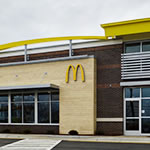If, as anticipated, a McDonald’s restaurant in Cary, North Carolina, achieves LEED Gold certification, it will be the fifth McDonald’s to do so in the United States. Five additional American restaurants under the “Golden Arches” await certification while several more have been certified in Canada, Mexico, Puerto Rico, Argentina, and Brazil.
This will be the second LEED restaurant in Cary for owner and operator Ric Richards, a McDonald’s franchisee since 1988 with a total of 11 restaurants under his wings. This particular store, completed in 2013, already pulls about 37 kilowatts from a solar canopy that covers the parking lot, has water-efficient restroom and kitchen fixtures, composts consumer and kitchen waste, and recycles cardboard and cooking oil.
Richards says he chose to seek LEED certification for several reasons. “We do business in an educated, diverse market,” he says, explaining that university science camps and area elementary schools have toured the facilities many times. Another reason is education of the supply chain. With Richards’ first LEED restaurant in 2009, weekly meetings with contractors and subcontractors covered the prescribed environmental renovation methods (both structures were rebuilds of existing restaurants). “LEED-qualifying demolition was new for them,” he says. “But they were completely engaged in it. The second LEED restaurant was less costly to build in part because subcontractors had a better understanding of the LEED program.”
Richards was influenced by an earlier LEED McDonald’s in Savannah, Georgia. Now, he says, interest among other operators is building. Rebuilding restaurants can cost between $1.2 and $2 million, with LEED-certified restaurants costing about five percent more than a traditional build.
From the corporate office in Oak Brook, Illinois, LEED-accredited in-house architect John L. Rockwell explains that operators’ decisions to pursue LEED certification is entirely theirs, though the company does support it. “McDonald’s has a huge legacy of efficiency in everything we do, especially in lighting and new equipment,” Rockwell says. “We hope to push LEED along to other operators.”
Indeed, McDonald’s is one of many multi-unit companies that is participating in the LEED Volume program, which is a streamlined means to achieve the green standard across many, similarly designed buildings. Rockwell says McDonald’s is endeavoring to get 25 restaurants certified by the end of 2015. Combined with the fact that the company’s vendor network is so large, this push may significantly drive green products and practices for other worldwide companies.

